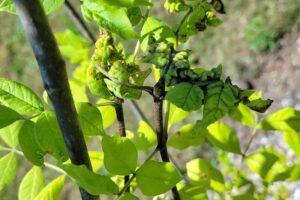Leaflet: Aphids
Aphids are everywhere, but don’t worry!
We’ve been getting a few inquiries about aphids this summer. And with the arrival of the emerald ash borer (a devastating issue we’ll keep you posted on), we have plenty of reasons to keep an eye out for pests. In the case of aphids, however, we don’t need to fret about them on our trees like we do in our veggie gardens.
In almost all instances, you don’t need to take any action—the tree can take care of itself. Aphids will only make a noticeable impact if the tree is still working to establish itself, or is somehow otherwise weakened. We often see them on Oregon ash, like the one pictured. If some wilting or crinkled leaves have you worried, here are some action steps you can take. Some folks might want to go straight to spraying, but pesticides really aren’t necessary to deal with aphids.
If you have more than just a few aphids on your leaves, the first thing to try is to just rinse them off with water. A good hose down will take care of a minor infestation. If that doesn’t quite do the trick, you can spray with soapy water. A treatment like this just once or twice a year will be enough.
If you see any ladybugs alongside the aphids, that’s great! Ladybugs will eat the aphids, and their larvae will really go to town feasting on them.
Aphids are everywhere—there are even tiny ones floating in the air we breathe. Some trees, like littleleaf linden, will have so many aphids that you may feel a mist of aphid “honeydew” when you walk underneath. You guessed it, that’s aphid poop. Just think of it as a nice reminder that trees are part of a larger ecosystem of living things.

